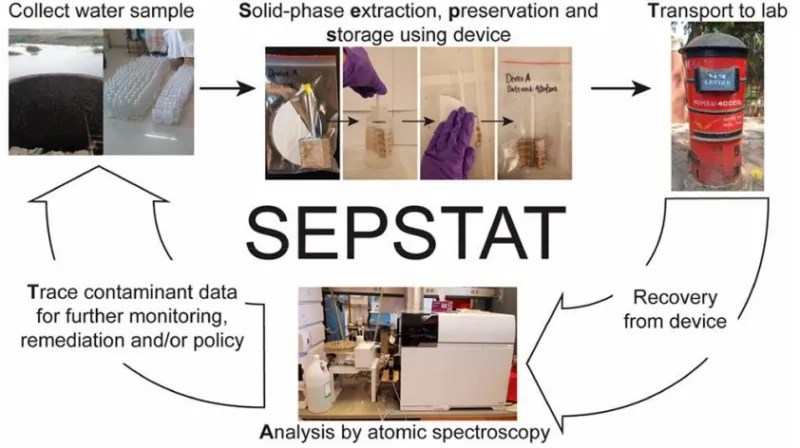Method for Preservation, Transport, and Analysis of Water Samples
This invention lays out an approach to greatly expand access to water quality testing rapidly and at low cost. Such access would improve the safety of drinking water in developing countries and areas relying on decentralized water supplies such as wells.
Researchers
-
system and method for preservation, transport, and analysis of water samples
United States of America | Granted | 11,726,015 -
system and method for preservation, transport, and analysis of water samples
United States of America | Granted | 11,131,609 -
system and method for preservation, transport, and analysis of water samples
India | Granted | 496,545
Figures
Technology
The invention constitutes a revolutionary strategy for simplifying the collection and transport of water samples with kits into which water can be added that capture and fix in a solid form all materials of interest for water quality testing. The approach is analogous to that previously pioneered for the transport and storage of blood: dried blood spot testing. Rather than transporting liquid samples of water, solid material representative of the water added to it is sent from the field to be centralized laboratories, where it can be analyzed with the greatest precision and thoroughness. The kit is centered around a “tea bag” which is to be steeped in the water, dried, and mailed to a central testing facility. This “tea bag” contains an adsorbent such as cellulose, polymers, clays onto which any impurities of the water will stick and any necessary chemical agents that will ensure the stability of the contaminants during transport or render them more easily detected during analysis. Ensuring that measurements done on the kit samples are comparable to actual water samples is as simple as calibrating results to samples analyzed by more conventional methods. The kits can be sent out in envelopes with return postage and used by untrained individuals. The kits’ simplicity allows them to be sent out broadly anywhere with postal service and can therefore empower every person to exercise their right to know their drinking water is safe, no matter how small or remote their water source may be.
Problem Addressed
Access to safe drinking water remains far from universal, especially in developing countries. Diarrhea alone accounts for an estimated 297,000 preventable deaths of children under the age of 5 each year according to the World Health Organization. Beyond acute illness, chronic exposure to pollutants such as heavy metals also remain widespread, with an estimated 150 million people each year exceeding the WHO’s recommended safe exposure limit for arsenic.
The current water testing paradigm consists of both field testing and centralized testing. Field tests are quick to perform and relatively cheap while centralized testing is more thorough and able to detect a wider variety of contaminants. While field testing is an effective means to “spot check” disparate and far-flung water sources on a regular basis, the gold standard for ensuring water is entirely fit for human consumption is in centralized well-equipped laboratories. The limiting factor in employment of centralized testing is the expense resulting from the relative difficulty of transporting vast numbers of water samples from numerous water sources. Furthermore, vast volumes of water cannot reasonably be kept on hand for future testing of historical water quality if a contaminant not previously tested for comes to be of interest.
Advantages
- More precise and thorough than field testing
- Cheaper transport of water samples
- Practical storage of historical samples
- Simple sample preparation enables democratization of testing.
Publications
Bono, et al. "Iron oxide xerogels for improved water quality monitoring of arsenic (III) in resource-limited environments via solid-phase extraction, preservation, storage, transportation, and analysis of trace contaminants (SEPSTAT)." Analytical Methods (2021).
Hanhauser, et al. "Solid-Phase Extraction, Preservation, Storage, Transport, and Analysis of Trace Contaminants for Water Quality Monitoring of Heavy Metals." Environmental Science & Technology (2020).
License this technology
Interested in this technology? Connect with our experienced licensing team to initiate the process.
Sign up for technology updates
Sign up now to receive the latest updates on cutting-edge technologies and innovations.
